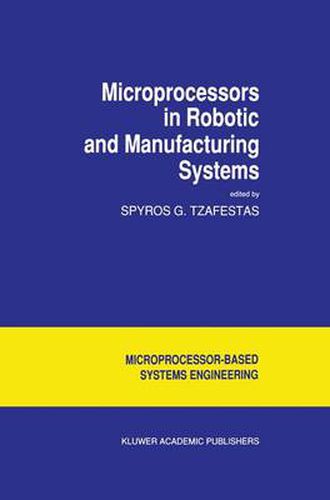Readings Newsletter
Become a Readings Member to make your shopping experience even easier.
Sign in or sign up for free!
You’re not far away from qualifying for FREE standard shipping within Australia
You’ve qualified for FREE standard shipping within Australia
The cart is loading…






This title is printed to order. This book may have been self-published. If so, we cannot guarantee the quality of the content. In the main most books will have gone through the editing process however some may not. We therefore suggest that you be aware of this before ordering this book. If in doubt check either the author or publisher’s details as we are unable to accept any returns unless they are faulty. Please contact us if you have any questions.
Microprocessors play a dominant role in computer technology and have contributed uniquely in the development of many new concepts and design techniques for modem industrial systems. This contribution is excessively high in the area of robotic and manufacturing systems. However, it is the editor’s feeling that a reference book describing this contribution in a cohesive way and covering the major hardware and software issues is lacking. The purpose of this book is exactly to fill in this gap through the collection and presentation of the experience of a number of experts and professionals working in different academic and industrial environments. The book is divided in three parts. Part 1 involves the first four chapters and deals with the utilization of microprocessors and digital signal processors ( DSPs ) for the computation of robot dynamics. The emphasis here is on parallel computation with particular problems attacked being task granularity, task allocation/scheduling and communication issues. Chapter I, by Zheng and Hemami, is concerned with the real-time multiprocessor computation of torques in robot control systems via the Newton-Euler equations. This reduces substantially the height of the evaluation tree which leads to more effective parallel processing. Chapter 2, by D'Hollander, examines thoroughly the automatic scheduling of the Newton-Euler inverse dynamic equations. The automatic program decomposition and scheduling techniques developed are embedded in a tool used to generate multiprocessor schedules from a high-level language program.
$9.00 standard shipping within Australia
FREE standard shipping within Australia for orders over $100.00
Express & International shipping calculated at checkout
This title is printed to order. This book may have been self-published. If so, we cannot guarantee the quality of the content. In the main most books will have gone through the editing process however some may not. We therefore suggest that you be aware of this before ordering this book. If in doubt check either the author or publisher’s details as we are unable to accept any returns unless they are faulty. Please contact us if you have any questions.
Microprocessors play a dominant role in computer technology and have contributed uniquely in the development of many new concepts and design techniques for modem industrial systems. This contribution is excessively high in the area of robotic and manufacturing systems. However, it is the editor’s feeling that a reference book describing this contribution in a cohesive way and covering the major hardware and software issues is lacking. The purpose of this book is exactly to fill in this gap through the collection and presentation of the experience of a number of experts and professionals working in different academic and industrial environments. The book is divided in three parts. Part 1 involves the first four chapters and deals with the utilization of microprocessors and digital signal processors ( DSPs ) for the computation of robot dynamics. The emphasis here is on parallel computation with particular problems attacked being task granularity, task allocation/scheduling and communication issues. Chapter I, by Zheng and Hemami, is concerned with the real-time multiprocessor computation of torques in robot control systems via the Newton-Euler equations. This reduces substantially the height of the evaluation tree which leads to more effective parallel processing. Chapter 2, by D'Hollander, examines thoroughly the automatic scheduling of the Newton-Euler inverse dynamic equations. The automatic program decomposition and scheduling techniques developed are embedded in a tool used to generate multiprocessor schedules from a high-level language program.